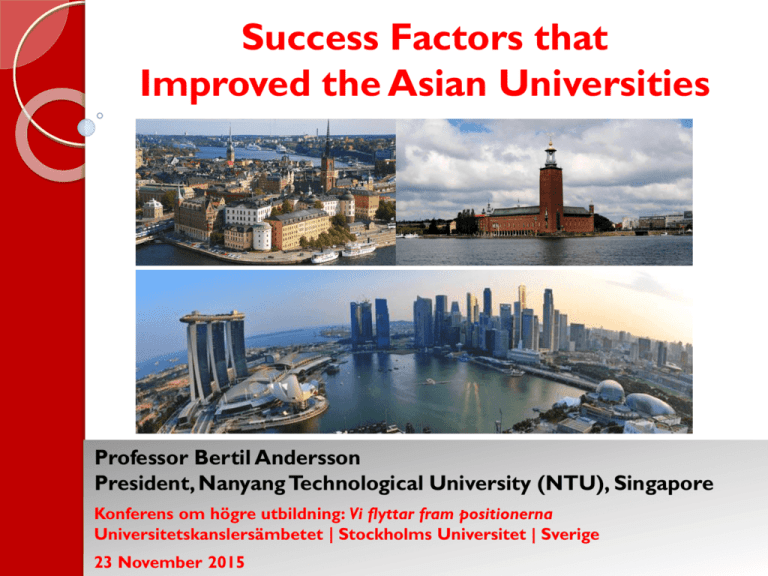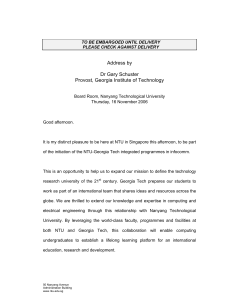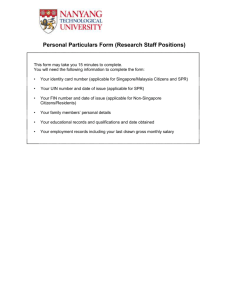Japan
advertisement

Success Factors that Improved the Asian Universities Professor Bertil Andersson President, Nanyang Technological University (NTU), Singapore Konferens om högre utbildning: Vi flyttar fram positionerna Universitetskanslersämbetet | Stockholms Universitet | Sverige 23 November 2015 The Tripartite Academic World Asia (NTU) Europe (Stockholm University) USA (Harvard) “Sometimes, we talk too much about competition here in Europe ... The rapid rise of academia in Asia is fantastic … A new part of this World is starting to contributing to the Global Knowledge.” Mr Leif Pagrotsky Former Swedish Minister for Education, Research & Culture, 2004 – 2006 The Heterogeneous Rise of Asia China: Rising (more quantity than quality) India: Slowly developing (private sector leading) Japan: Stagnant at a high level Taiwan: Stagnant at a relatively high level or even declining Hong Kong: High-level quantity & quality Korea: Strong & rapid development Singapore: Strong & rapid development Malaysia / Thailand / Indonesia / Vietnam: Slow development World of R&D (2014) Source: Battelle, R&D Magazine Global Scientific Output Trends: Major Contributor of World Publications 1940s 1970s 2010s 19 Asian Universities in QS Top-100 (10 in Top-50) Rank (Rank in 2010) Name of institution Country Rank (Rank in 2010) Country 12 (31) National University of Singapore Singapore 43 (79) KAIST – Korea Advanced Institute of Science & Technology South Korea 13 (74) Nanyang Technological University (NTU) Singapore 51(42) Chinese University of Hong Kong Hong Kong 25 (54) Tsinghua University China 51(105) Fudan University China 28 (40) Hong Kong University of Science & Technology Hong Kong 56 (60) Tokyo Institute of Technology Japan 30 (23) University of Hong Kong Hong Kong 57 (129) City University of Hong Kong Hong Kong 36 (50) Seoul National University South Korea 58 (49) Osaka University Japan 38 (25) Kyoto University Japan 70 (94) National Taiwan University Taiwan 39 (24) University of Tokyo Japan 70 (151) Shanghai Jiao Tong University China 41(47) Peking University China 74 (102) Tohoku University Japan 87 (112) Pohang University of Science & Technology (POSTECH) South Korea Highest ranked Swedish University: 70th (Lund University) 9 Asian Universities in Times Higher Education Top-100 (5 in Top-50) Rank Name of institution (Rank in 2010) Country 26 (34) National University of Singapore Singapore 42 (37) Peking University China 43 (26) University of Tokyo Japan 44 (21) University of Hong Kong Hong Kong 47 (58) Tsinghua University China 55 (174) Nanyang Technological University (NTU) Singapore 59 (41) Hong Kong University of Science & Technology Hong Kong 85 (109) Seoul National University South Korea 88 (57) Kyoto University Japan 28th 2 highest ranked Swedish universities: (Karolinska Institutet) & 81st (Uppsala University) Country No. of universities in QS Top-100 Singapore 2 2 Japan 5 2 China 4 2 Hong Kong 4 2 South Korea 3 1 Taiwan 1 – Total 19 9 Country No. of universities in Times Higher Education Top-100 Best university in QS World University Rankings 2015 (Rank) Best university in QS World University Rankings 2010 (Rank) Malaysia Universiti Malaya (146) Universiti Malaya (207) India Indian Institute of Science Bangalore (147) Indian Institute of Tech Delhi (202) Thailand Chulalongkorn Uni (253) Chulalongkorn Uni (180) Indonesia University of Indonesia (358) University of Indonesia (236) Philippines University of the Philippines (401-410) Ateneo de Manila University (307) Asian Normalised Research Impact Trends (NTU Top in Asia) Source:Thomson Reuters Normalised Research Impact Trends (NTU vs Top Universities) Source:Thomson Reuters OECD Global Schools Rankings (Top 10) Based on test scores in Maths & Science, at age 15, in 76 countries 1) Singapore 6) Finland 2) Hong Kong 7) Estonia 3) South Korea 8) Switzerland 4) Japan 9) Netherlands 4) Taiwan 10) Canada Sweden ranked 35th Perceptions of Asian Students Excellent & disciplined Pressurised Not creative Attracted to study in the West Singapore – East Meets West Gained independence in 1965 Population size: ≈ 5.47 million (2014) Land area: 718 sq km (2014) English as the working language 3rd richest country in the World (2014): GDP per capital S$ 71,318 (≈ €49,100) GERD target: 3.5% Multicultural, highly cosmopolitan & diverse with people of Chinese, Malay, Indian & other ethnicities A rapidly emerging country when it comes to Academia & Research 6 universities (including NTU & NUS) + A*STAR Singapore The Singapore Government “Walks the Talk” for the Knowledge Society • Research, Innovation & Enterprise Council (RIEC): Chaired by the Prime Minister of Singapore, it brings together world-leading experts & 9 Cabinet Ministers to ADVISE the Singapore Cabinet on national research & innovation policies & strategies to drive the transformation of Singapore into a knowledge-based economy 5-year Science & Technology plan for research funding Source: A*STAR 2016-2020 S$19 billion est. (120 billion SEK) 15% increase *Does NOT include basic funding for the universities NTU’s Basic Facts & Figures 1991: Establishment of Nanyang Technological University (NTU) Total student population: ≈ 33,200 24,300 undergraduates ≈ 8,900 graduate students International students: 15% of undergrads (11.6% for AY15) 53% of Masters 76% of PhDs Total staff strength: ≈ 7,310 ≈ 1,660 faculty, with 967 international faculty ≈ 2,890 research staff ≈ 2,760 admin & support staff The NTU College Structure College of Engineering College of Business College of Science 70% of international faculty & research staff College of Humanities, Arts & Social Sciences Lee Kong Chian School of Medicine National Institute of Education NTU – A Fast Rising University Recently ranked the world’s no. 1 fastest rising young university by Times Higher Education Ranked 13th in QS World University Ranking - Quantum leap of 61 places over 5 years Ranked 55th in Times Higher Education World University Rankings - Quantum leap of 119 places over 5 years Ranked 1st in QS Top-50 under 50 Ranked 6th in Engineering & Technology (QS Rankings by area) 74th in 2010 174th in 2010 4th in 2012 NTU in 2000… Educational Focus Limited to Engineering & Business Research not encouraged Old academic structure Ad-hoc recruitment / promotion Totally in the shade of NUS… What catalysed the rapid climb? Broadening of Academic Portfolio 2002 • Life Sciences 2005 • Humanities & Social Sciences 2005 • Natural Sciences / Mathematics 2005 • Art School 2010 • Medicine (partnership with Imperial College London) 2014 • Environmental Sciences Revitalising Human Resources American-based appointment, promotion & tenure system with high bar for success Applied retroactively to all faculty at NTU (2007-2009) Out of 750 cases, one-third did not make the cut Strong emphasis on international recruitment: International stars & young upcoming post-docs (ERC-type) Non-Fatalistic Strategy Strong governance: A high-level & pro-active university Board Top-down university management (with big ears) Strategic plan with prioritised areas Economical incentives for success Strong follow-up culture from Board & Ministry Emphasis on Research For promotion & tenure Start up research funding / seed funding Initially Push reduced teaching load for new hires for external competitive research funding Establishment of interdisciplinary thematic research centres Priority of research areas in so-called Peaks of Excellence International academic & industrial partnerships Reform of Education – Reduction in Passive Consumption of Lectures Broader education; Interdisciplinarity New pedagogy: ICT, MOOCs, Flipped classrooms Elite programmes Humboldtian principle: All professors do research Infrastructure Investment NTU investing >S$1.8 billion in new infrastructure Halls of residence for students; 50% more residential rooms for students 16,000 students on campus; 1,000 professors Medical school 24-hours learning hubs Research labs Restaurants, cafes, etc Universities Today are GLOBAL – Taking NTU to the World & Bringing the World to NTU International academic & industrial collaborations Global international leadership Ambition that 80% of all NTU undergraduate students spend 1 semester abroad Global Dialogue at NTU (Partnerships with Times Higher & the Nobel Foundation) 70% international faculty & research staff NTU satellites abroad eg. London / Berkeley NTU’s Outbound & Inbound Exchange Mobility (AY 2014/2015) Singapore students love Sweden; Swedish students love Singapore Asia & Singapore are developing very fast What about Europe & Sweden? Academically, the West has influenced the East In future, will the East start to influence the West? Sweden Singapore Thank you




